Do you have one or more electric company cars in your company? Congratulations, you are committed to climate-friendly mobility! But did you know that you can also earn money with an e-car? GHG quota trading makes it possible. In this blog post, we’ll tell you exactly what this is and why you should take advantage of it.
Electromobility is gaining ground in corporate mobility. Initially, it was mostly large companies that gradually electrified their fleets, but now more and more smaller fleets are also opting for electric vehicles. There are many reasons for this. On the one hand, the rising price of gasoline is turning combustion engines into cost drivers, while on the other hand, electric vehicles have become much more attractive in recent years. Also thanks to various state subsidies. Financing models such as the car subscription also make it possible to test in advance how e-vehicles work in the fleet.

What is the GHG quota?
The GHG quota is a type of emissions trading between the legislator and private individuals or companies. THG is short for greenhouse gas reduction quota and is part of a package of measures by the German government. It should help to significantly reduce greenhouse gas emissions in transportation.
The quota was launched back in 2007 under the name biofuel quota, but was only known to a small circle for a long time. The issue of climate protection is becoming increasingly urgent, which is why the THQ quota has once again become a topic of discussion in recent years.
The quota is intended to encourage both companies and private individuals to opt for climate-friendly means of transportation. They then receive funding from the federal government. The quota is the percentage of sustainable fuels in relation to the total amount available, including fossil fuels. It increases every year and is set to rise to 22% by 2030.
How does the GHG quota work?
The GHG quota is mandatory for companies. For example, mineral oil companies are to reduce their greenhouse gas emissions with the help of the quota, as they can no longer rely entirely on fossil fuels. The principle of the quota is simple: either companies replace fossil fuels with climate-friendly alternatives or they buy emissions certificates from third parties that have exceeded the THQ quota. These can be owners of charging stations for electric vehicles, but also other companies. The prerequisite is that companies can only engage in emissions trading with groups that have already fulfilled the quota.
Larger companies can buy emissions certificates from emissions traders or via the Federal Environment Agency. Fleets with electric vehicles can apply for a certificate for each electric car. The current price for a certificate is between 250 and 360 euros, also based on theCO2 price. Operators of charging stations and owners of electric vehicles benefit the most, as the prices for the GHG quota are significantly higher here.
Why the GHG quota is so important
The GHG quota is important because it not only promotes a climate-friendly transport transition, but also penalizes those who continue to rely on fossil fuels. Whether fleets of large companies, chemical plants or globally operating mineral oil companies: the quota allows the Federal Government to commit companies and citizens to sustainable mobility and economic efficiency.
The GHG quota in the vehicle fleet
The vehicle fleet of tomorrow will be electric, that’s for sure. However, it is also clear that the majority of company cars are still not powered by climate-friendly drives. The GHG quota is a sensible solution for advancing the “green transport transition”, even if it is not the all-encompassing solution. In particular, companies thatemita lot ofCO2are required by the GHG quota to change their production processes. For small fleets, the GHG quota offers the opportunity to deduct further costs in addition to the existing subsidies for e-vehicles.
The most important facts about the placeholder contribution at a glance
The GHG quota is intended to promote the stable and long-term implementation of sustainable biofuels.
This primarily affects large companies with particularly high emissions.
Since January 1, 2022, private individuals have also been able to participate in GHG quota trading and thus sell their saved greenhouse gas emissions to quota holders.
Private quota trading between two private individuals is not permitted.


